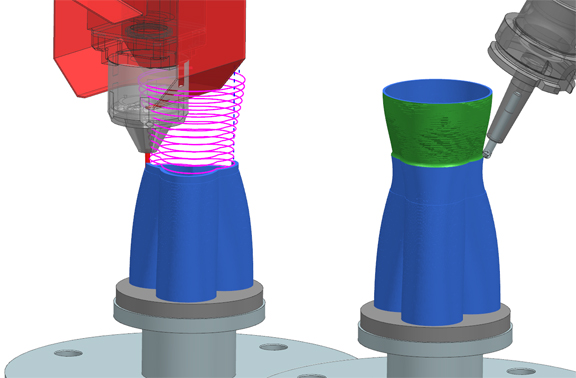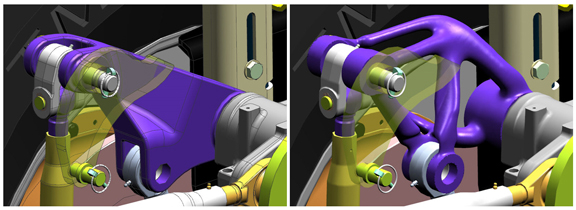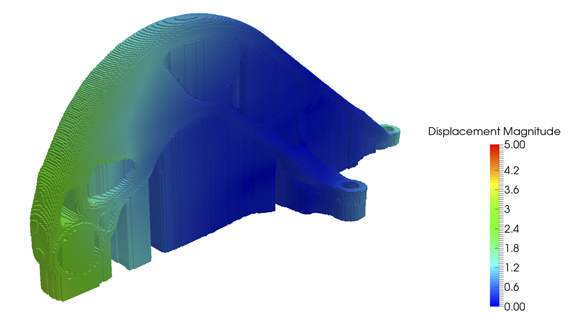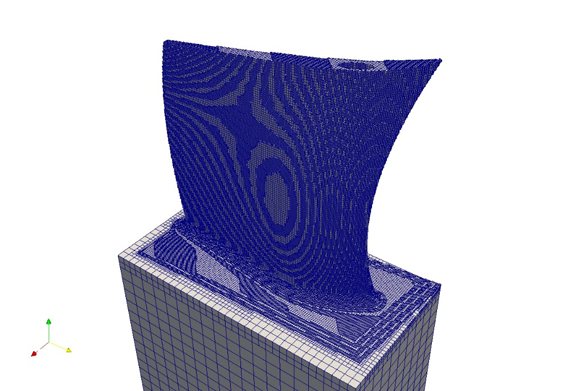
Siemens’ NX Hybrid Additive Manufacturing provides laser and NC programming with simulation for the DMG MORI Lasertec machine tool series where metal deposition is incorporated with machining methods on a single machine so new classes of parts with complex geometries and interior cavities can be easily manufactured in a single setup.
Latest News
October 24, 2016
 Siemens’ NX hybrid additive manufacturing paves the way for new classes of parts with complex geometries and interior cavities to be manufactured in a single setup. (Image courtesy of Siemens PLM Software)
Siemens’ NX hybrid additive manufacturing paves the way for new classes of parts with complex geometries and interior cavities to be manufactured in a single setup. (Image courtesy of Siemens PLM Software) The part on the left is designed for conventional machining. The part with organic shape on the right has been optimized for 3D printing with reduced mass and equal strength. Both are made possible by in Siemens PLM Software’s generative design and simulation features. (Image courtesy of Siemens PLM Software)
The part on the left is designed for conventional machining. The part with organic shape on the right has been optimized for 3D printing with reduced mass and equal strength. Both are made possible by in Siemens PLM Software’s generative design and simulation features. (Image courtesy of Siemens PLM Software)In a recent webcast on Bottlenecks in Simulation (with Tech-Clarity’s Michelle Boucher, webcast now available online), a caller asked, “How about process simulation for additive manufacturing? Isn’t that a challenge in simulation?”
It is, indeed, a challenge, something of a void at the present. You can find a robust collection of process-simulation software for machining, injection molding, and other classic manufacturing methods. But not for additive manufacturing (AM) or 3D printing. In its infancy AM printing was perceived as a prototyping method, not a manufacturing method; therefore, simulating the process seemed unnecessary. But in the recent years, more and more manufacturers, led by automotive and aerospace giants, have begun exploring AM as a way to create products with shapes that are impossible or too costly to produce using traditional manufacturing methods. Now, the race to fill the AM gap is on.
Last week, Siemens PLM Software announced that it will roll out an “end-to-end additive manufacturing solution” in January 2017.
The company writes, “The solution will enable automated generative design using the new topology optimization capabilities, which often result in organic shapes that would be difficult for a human designer to envision, and impractical or impossible to produce with traditional manufacturing techniques ... [In addition to generative design and topology optimization,] Siemens is also introducing a new 3D print preparation solution for both metal and plastic parts ... The new solution assists operators in preparing parts for powder bed and multi jet fusion printing.”
Siemens PLM Software’s NX CAD and simulation program will be the centerpiece for the post-printing and model-preparation operations.
 Simulating the 3D printing process and verifying the support structure’s integrity in Autodesk technology. (Image courtesy of Autodesk)
Simulating the 3D printing process and verifying the support structure’s integrity in Autodesk technology. (Image courtesy of Autodesk) Simulating a 3D print job in Autodesk Netfabb. (Image courtesy of Autodesk)
Simulating a 3D print job in Autodesk Netfabb. (Image courtesy of Autodesk)A few weeks before Siemens PLM Software’s announcement, Autodesk launched what it calls a “Portfolio for the Future of Manufacturing.” To create the comprehensive suite, the company brought together a number of its existing brands—Delcam, HSM, and Netfabb, among others—to address both additive and subtractive manufacturing.
Netfabb was an industrial additive design and manufacturing software developed by a Germany-based company. In 2015, Autodesk acquired the firm and its technology. In doing so, Autodesk also became the vendor for more than 80,000 designers, manufacturers, artists, researchers and developers worldwide who were said to be using netfabb for their 3D printing projects.
Netfabb is available in Standard, Premium, and Ultimate Editions under Autodesk subscription plan. Standard covers prototyping and file preparation. Premium covers production and machining operations. Ultimate covers design for AM, and part and process optimization.
The use of AM for prototyping is relatively simple. A CAD software program capable of exporting printer-friendly files and some geometry cleanup tools (often comes with the 3D printer) can accomplish the task. But industrial scale AM—especially metal-based printing—presents difficult challenges. Practitioners will likely face the use of lattice or honeycomb structures to reduce weight, the need to automatically generate such structures with algorithms, and the know-how to add the support structures necessary for certain print jobs. The process gets more complicated for those attempting AM with composite materials.
By the estimates of Wholers Associates, “The AM industry, consisting of all AM products and services worldwide, grew 25.9% (CAGR) to $5.165 billion in 2015. The CAGR for the previous three years was 31.5%. Over the past 27 years, the CAGR for the industry is an impressive 26.2%.”
Leadership positions in the AM hardware market is well-established, with the MakerBot line (own by Stratasys) dominating the consumer space and the Objet brand (own by Stratasys) and 3D Systems products largely claiming the professional market. But the AM software and services space is still evolving, with enough room for newcomers. It’s open to CAD vendors, like Autodesk and Dassault, and also to simulation software makers, like ESI and ANSYS.
Subscribe to our FREE magazine, FREE email newsletters or both!
Latest News
About the Author
Kenneth Wong is Digital Engineering’s resident blogger and senior editor. Email him at [email protected] or share your thoughts on this article at digitaleng.news/facebook.
Follow DE





